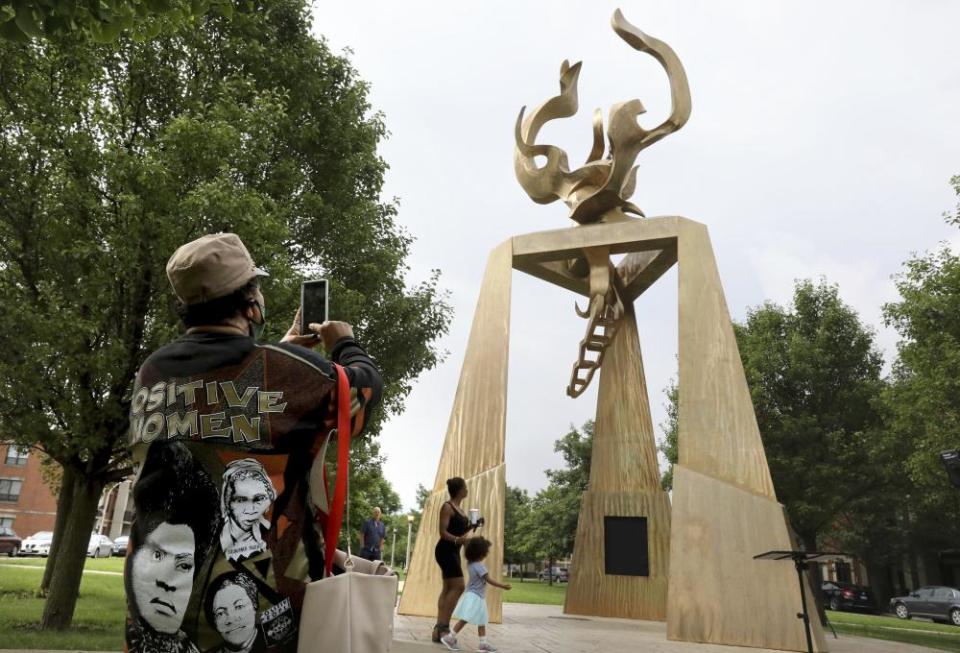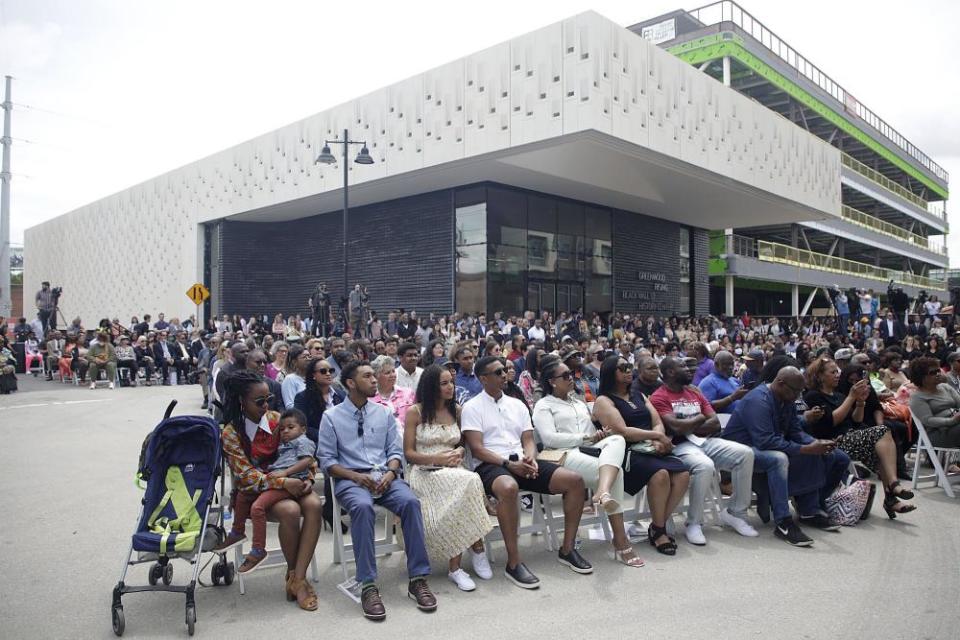‘We have to be part of the solution’: building the Black Wall Streets of tomorrow
When most people hear the words “Black Wall Street”, their thoughts tend to dart straight to Greenwood, the prosperous Tulsa enclave that rose to prominence in the early 1900s and lay in ruins after the 1921 Tulsa massacre. In a horrific flashpoint of US history, a white mob descended on the north Tulsa neighborhood, looting and burning down Black-owned businesses and killing approximately 300 people.
Related: These tastemakers want Black food to be more than a side dish
Phil Armstrong, a Tulsa resident and the president and CEO of the Oklahoma Center for Community and Justice, says that the ruinous massacre is only half the story. In fact, the city of Tulsa began rebuilding the Greenwood district almost immediately after the riots. By 1942, one year after the devastation, the zone was home to 242 Black-owned businesses including bowling alleys, hotels and boutiques – double the amount there had been 12 months prior.
“The focus was to get the economy of Greenwood up and running again as soon as possible,” Armstrong says.
The legacy and resilience of the Black Wall Street of Tulsa is inspiring a new generation to rebuild Black business districts across the nation. From St Louis to Chicago, urban citizens are working to put Black commercial districts back on the map.
St Louis
Inspired by the efforts to rebuild the Greenwood district of Tulsa, St Louis organizer Farrakhan Shegog founded Young Voices With Action (YVWA), a St Louis nonprofit dedicated to the revitalization of the Wellston Loop corridor that runs along Martin Luther King Boulevard. Shegog was motivated to re-create the glory days of the Ville, a predominantly Black enclave of St Louis that was home to Arthur Ashe, Tina Turner, Chuck Berry and Josephine Baker, among others. Though most of the businesses in the Ville were not Black-owned, the bustling district gave its Black residents and customers a sense of pride. “It was during Jim Crow, and it was the one place in St Louis that allowed Black people to walk through the front door,” Shegog says.
In 2017, his organization launched the Black Wall Street 314 festival in order to raise funds for home improvements, neighborhood stability and advocacy work to benefit local residents. It draws more than 100 Black vendors. The original plan was to use the profits from the festival to buy vacant lots and homes for those in need. But before they could even think about redevelopment, Shegog’s group had to devote their efforts to warding off gentrification. In 2020 the development firm Equity Homes announced a plan to build $300,000 homes in a neighborhood with residents that have a median annual income of $20,000.
There were a lot transactions taking place in our community which resulted in a transfer of wealth to individuals outside of the community
Farrakhan Shegog
YVWA currently has site control of a vacant lot on Martin Luther King Boulevard, with a plan build the Easton Resident Business Center, a mixed-used development. The project will include four retail spaces and 16 affordable housing units. In June of 2022, YVWA received $916,000 from Congresswoman Cori Bush toward the cost of the project. YVWA has raised $8.8m so far, with an additional $1.4m needed in order to buy the deed to the land.
“There were a lot of land and real estate transactions taking place in our community which resulted in a transfer of wealth from the impacted community to individuals outside of the community,” Shegog says.
His group began to aggressively acquire residential properties. It also took ownership of a community garden. The nonprofit was now a credible stakeholder in the neighborhood, making it hard for developers to act without input from the group. “They can no longer come to the community and ignore the community,” Shegog says.
In the meantime, the organization is implementing an anti-displacement fund and property tax relief assistance program. Supported by a $100,000 grant from the St Louis Port Authority, the program enables Shegog’s group to assist seniors and veterans on fixed incomes. His group has also received a $635,000 public safety grant. The money will go toward implementing new technologies like stoplights and cameras that contribute to public safety and encourage home ownership, with a view to bringing in members of the Black community.
Chicago
A collection of colorful shipping containers on East 51st Street in Chicago’s historic Bronzeville district houses the Boxville Marketplace, an enterprise hub featuring Black-owned businesses. The modified shipping containers are part of Build Bronzeville, an economic development program that the nonprofit Urban Juncture created to revitalize the community.
Raised in Liberia, Build Bronzeville founder Bernard Lloyd says he became “excited about the power of economics to change the community” after completing an economics course. “Black Chicago formed modern day Chicago, and what I mean by that is the Black migration brought hundreds of thousands of Black people to Chicago,” Bernard says.

As recently as 1980, Chicago’s population was 40% Black. Musicians like Louis Armstrong, Nat King Cole and Mahalia Jackson hailed from Bronzeville, dubbed “the Black metropolis”. Writer Ida B Wells, Olympic legend Jesse Owens and boxing champion Joe Louis also called Bronzeville home.
Mass migration hit the city around the turn of the millennium, which resulted in the loss of 261,673 Black residents from 2000 to 2020. To stem this tide, Lloyd’s first instinct was to lure Black people back by developing a restaurant row featuring Black cuisine, but he soon realized the sight of urban decay was going to turn off potential customers. So his team worked to buy three properties, but when the 2008 financial crisis hit, their investment partners disappeared. That’s when they decided to create a community garden.
The effort evolved into five more initiatives: the Bronzeville Business Incubator, Boxville, the Bronzeville Cookin’ facility, Engage Bronzeville and the Forum, a retail and hospitality complex. Lloyd says it will cost around $50m to bring the entire vision to fruition.
Tulsa
The historic Greenwood district is now home to a growing business and tech sector, as well as a thriving housing market.
It hasn’t come easy. In 1967, the city of Tulsa demolished homes and businesses in the area to build Interstate 244 and Highway 75. What followed was a surge of conflict, with locals fighting to save their neighborhoods and descendants of victims and survivors of the Tulsa massacre working to receive reparations. After a long and unsuccessful battle for reparations, the North Tulsa Economic Development Initiative formed in 2007 with a mission to rebuild north Tulsa, one project at a time. Then in 2015, Senator Kevin Matthews formed the 1921 Tulsa Race Massacre Centennial Commission to raise funds for the 100-year commemoration of the massacre. The commission led the charge to build Greenwood Rising, a history center dedicated to the legacy of Black Wall Street.

In 2018, the Tulsa Development Authority acquired 56 acres (23 hectares) from the University Center at Tulsa. The area includes Kirkpatrick Heights and Greenwood, which encompass such Black landmarks as the Greenwood Cultural Center, the Greenwood Rising history center, Mt Zion Baptist Church and Langston University, an HBCU. Tulsa’s mayor, GT Bynum, formed an 11-member leadership committee to ensure all plans for the 56 acres of the Kirkpatrick Heights and Greenwood redevelopment includes social and economic components for Black Tulsans.
“They put it back in our hands so we’re deciding what goes on,” says Lana Tuner-Addison, president of the North Tulsa Economic Development Initiative. Her nonprofit’s role is to advocate for Tulsans who don’t have the advantage of wealth or the ear of real estate developers. “Even though you’re not invited to the table, you have to include yourself and hold the city accountable,” she says. In 2016, the city committed $7m toward the initiative and additional funds to support north Tulsa development and infrastructure.
In 2019, Black Tulsans found themselves up against the threat of gentrification of north Tulsa in an area outside the circumscribed 56 acres of redevelopment. A grassroots campaign was formed to stop developers from acquiring even more property and using eminent domain laws to their advantage. “When anyone says urban renewal, we hear ‘urban removal’, or the removal of Black people,” Turner-Addison says.
When anyone says urban renewal, we hear ‘urban removal’, or the removal of Black people
Lana Tuner-Addison
It wasn’t until the centennial of the Tulsa massacre, when the whole world was watching, that the city decided to step up, says Turner-Addison. The city approved $2m for the construction of the Greenwood Plaza, an open-air art and entertainment venue in north Tulsa. Mayor Bynum, who is white and belongs to the Republican party, presented a $772m tax package for city improvements on 22 March. The amount that will go toward the Kirkpatrick Heights and Greenwood redevelopment is unknown.
Turner-Addison holds back tears as she talks about the lasting effects of the longstanding racism that has devastated the Black community of her city. “It doesn’t feel good to know about the wealth that was once there and what happened,” Turner-Addison says. “It hurts.” And yet she is looking to the future. “We also recognize that there are so many barriers in front of us, but we have to be part of the solution.”
Patience is key to building new Black business districts, says Armstrong from the Oklahoma Center for Community and Justice. By his estimates, it will take five to seven years to see the results of the collective efforts nationwide. His advice to community leaders is not to give in to frustration.
“The business districts will never be what they were 100 years ago,” he says. “It’s about creating new places where Black people can live and thrive.”

 Yahoo Finance
Yahoo Finance 